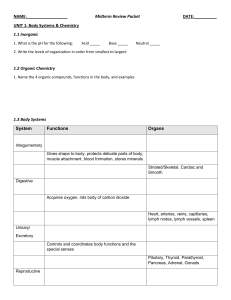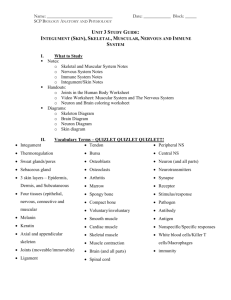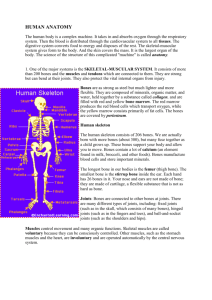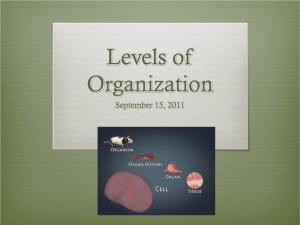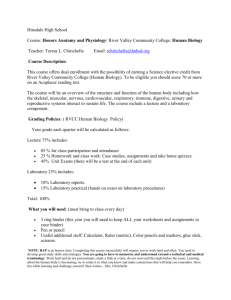Lecture Objectives
advertisement
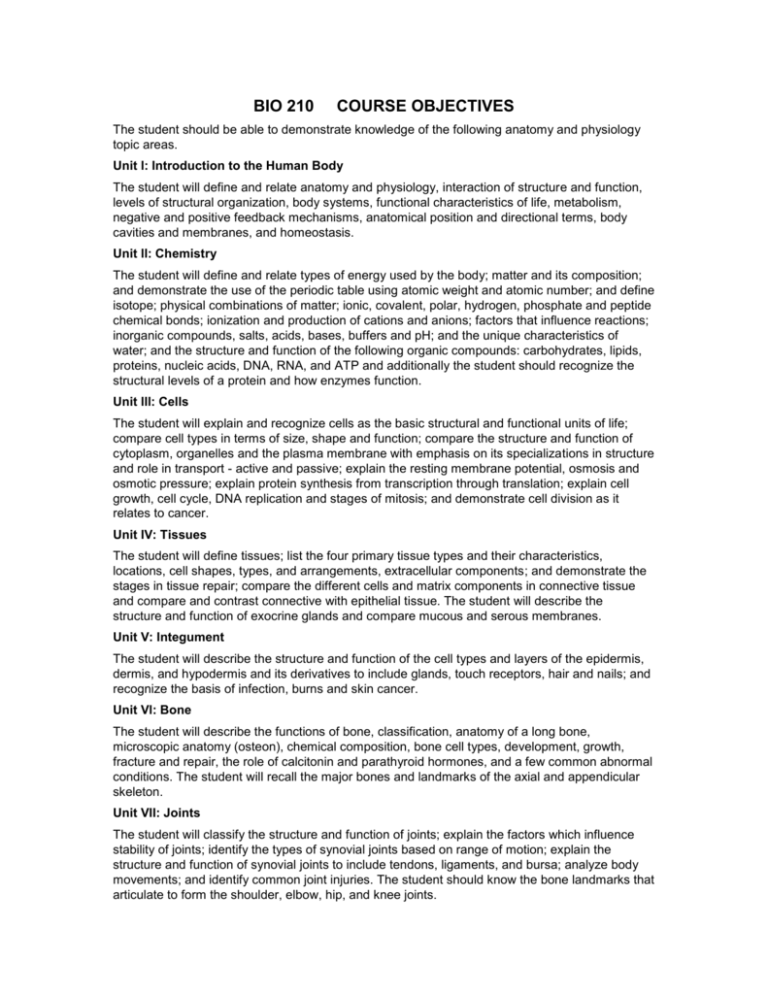
BIO 210 COURSE OBJECTIVES The student should be able to demonstrate knowledge of the following anatomy and physiology topic areas. Unit l: Introduction to the Human Body The student will define and relate anatomy and physiology, interaction of structure and function, levels of structural organization, body systems, functional characteristics of life, metabolism, negative and positive feedback mechanisms, anatomical position and directional terms, body cavities and membranes, and homeostasis. Unit ll: Chemistry The student will define and relate types of energy used by the body; matter and its composition; and demonstrate the use of the periodic table using atomic weight and atomic number; and define isotope; physical combinations of matter; ionic, covalent, polar, hydrogen, phosphate and peptide chemical bonds; ionization and production of cations and anions; factors that influence reactions; inorganic compounds, salts, acids, bases, buffers and pH; and the unique characteristics of water; and the structure and function of the following organic compounds: carbohydrates, lipids, proteins, nucleic acids, DNA, RNA, and ATP and additionally the student should recognize the structural levels of a protein and how enzymes function. Unit lll: Cells The student will explain and recognize cells as the basic structural and functional units of life; compare cell types in terms of size, shape and function; compare the structure and function of cytoplasm, organelles and the plasma membrane with emphasis on its specializations in structure and role in transport - active and passive; explain the resting membrane potential, osmosis and osmotic pressure; explain protein synthesis from transcription through translation; explain cell growth, cell cycle, DNA replication and stages of mitosis; and demonstrate cell division as it relates to cancer. Unit IV: Tissues The student will define tissues; list the four primary tissue types and their characteristics, locations, cell shapes, types, and arrangements, extracellular components; and demonstrate the stages in tissue repair; compare the different cells and matrix components in connective tissue and compare and contrast connective with epithelial tissue. The student will describe the structure and function of exocrine glands and compare mucous and serous membranes. Unit V: Integument The student will describe the structure and function of the cell types and layers of the epidermis, dermis, and hypodermis and its derivatives to include glands, touch receptors, hair and nails; and recognize the basis of infection, burns and skin cancer. Unit Vl: Bone The student will describe the functions of bone, classification, anatomy of a long bone, microscopic anatomy (osteon), chemical composition, bone cell types, development, growth, fracture and repair, the role of calcitonin and parathyroid hormones, and a few common abnormal conditions. The student will recall the major bones and landmarks of the axial and appendicular skeleton. Unit VII: Joints The student will classify the structure and function of joints; explain the factors which influence stability of joints; identify the types of synovial joints based on range of motion; explain the structure and function of synovial joints to include tendons, ligaments, and bursa; analyze body movements; and identify common joint injuries. The student should know the bone landmarks that articulate to form the shoulder, elbow, hip, and knee joints. Unit VIII: Muscles The student will recognize muscles and bones working as levers; compare and contrast the characteristics of the basic types of muscles; describe the microscopic structures and functional aspects of skeletal muscles, skeletal muscle attachments, coverings, patterns of fascicle arrangements, and explain a motor unit; discuss the sliding filament theory and excitation/contraction coupling, and list the order of events leading to muscle contraction and relaxation, and muscle response to exercise. The student will list the criteria for muscle names, and the names of major skeletal muscles. Unit IX: Nervous System The student will explain the organization of the nervous system, histology and function of nervous tissue and neuroglial cells, classification of neurons, structure and function of myelin in nervous impulses and regeneration. The student will describe polarized membranes, depolarization, repolarization, and hyperpolarization, receptor potentials, graded potentials, and action potentials, chemical synapses, and types of neurotransmitters. The student will explain the differences between nuclei, ganglia, nerves and tracts. Unit X: Central Nervous System The student will assess how the brain provides for interpretation of sensations, voluntary movements, integration, consciousness, and cognitive function. The student will recognize the structural and functional areas of the brain to include: ventricles, cerebrum and its surface features, diencephalon, brain stem, cerebellum, limbic system, reticular system, and meninges. The student will describe the gross structure of the spinal cord, its protection and anatomical cross section. Unit XI: Peripheral Nervous System The student will identify the cranial nerve number, name and function; and identify the spinal nerves - ventral and dorsal roots, dorsal root ganglia, and the major nerve from each plexus; major peripheral nerves. The student will explain the components of a reflex arc, reflexes, and classify the general receptors. Unit XII: Autonomic Nervous System The student will recognize the ANS as a motor division of the PNS; and will identify sympathetic and parasympathetic systems and control of the ANS and target responses; and will describe the role of the adrenal medulla. The student will compare and contrast the pre- and post-ganglionic fibers, the neurotransmitters and receptors of the ANS. Unit XIII: Neural Integration The student will describe sensation as an awareness of internal and external stimuli, perception as a conscious interpretation of stimuli, levels of processing sensory and motor signals, and describe brain wave patterns seen in EEGs emphasizing the differences in frequency and amplitude of waves. Unit XIV: Special Senses The student will describe in detail the structure and function of the special receptors and accessory structures of taste, olfaction, vision, hearing, and equilibrium and will explain the neural pathway for processing each sense.
